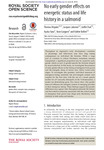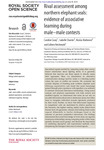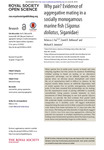Search
Now showing items 1-10 of 76
Can outcomes of dyadic interactions be consistent across contexts amongwild zebrafish?
(The Royal Society, 2015)
Winner–loser relations among group-living individuals are often measured by the levels of aggressive interactions between them. These interactions are typically driven by competition for resources such as food and mates. ...
Repeatability in the contact calling systemof Spix’s disc winged bat
(2015)
Spix’s disc-winged bat (Thyroptera tricolor) forms cohesive groups despite using an extremely ephemeral roost, partly due to the use of two acoustic signals that help individuals locate roost sites and group members. While ...
Light-emitting diode street lights reduce last-ditch evasivemanoeuvres by moths to bat echolocation calls
(The Royal Society, 2015)
The light-emitting diode (LED) street light market is expanding globally, and it is important to understand how LED lights affect wildlife populations. We compared evasive flight responses of moths to bat echolocation calls ...
The importance of delineating networks by activity type in bottlenose dolphins (Tursiops truncatus) in CedarKey, Florida
(The Royal Society, 2015)
Network analysis has proved to be a valuable tool for studying the behavioural patterns of complex social animals. Often such studies either do not distinguish between different behavioural states of the organisms or simply ...
No early gender effects on energetic status and life history in a salmonid
(2015)
Throughout an organism’s early development, variations in physiology and behaviours may have long lasting consequences on individual life histories. While a large part of variation in critical life-history transitions ...
Rival assessment among northern elephant seals
(The Royal Society, 2015)
Specialized signals emitted by competing males often convey honest information about fighting ability. It is generally believed that receivers use these signals to directly assess their opponents. Here, we demonstrate an ...
Object localization using a biosonar beam
(The Royal Society, 2015)
Determining the location of a sound source is crucial for survival. Both predators and prey usually produce sound while moving, revealing valuable information about their presence and location. Animals have thus evolved ...
Self organized flexible leadership promotes collective intelligence in human groups
(The Royal Society, 2015)
Collective intelligence refers to the ability of groups to outperform individual decision-makers. At present, relatively little is known about the mechanisms promoting collective intelligence in natural systems. We here ...
Greater magnocellular saccadic suppression in high versus low autistic tendency suggests a causal path to local perceptual style
(The Royal Society, 2015)
Saccadic suppression—the reduction of visual sensitivity during rapid eye movements—has previously been proposed to reflect a specific suppression of the magnocellular visual system, with the initial neural site of that ...
Why pair? Evidence of aggregativemating in a sociallymonogamous marine fish
(The Royal Society, 2015)
Many species live in stable pairs, usually to breed and raise offspring together, but this cannot be assumed. Establishing whether pairing is based on mating, or an alternative cooperative advantage, can be difficult, ...










